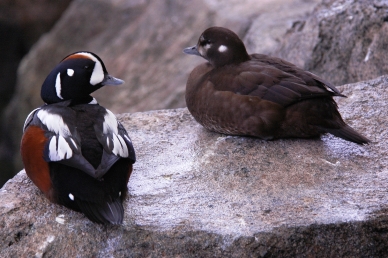Alaska Species Explorer
All
x
- – No known individuals remaining.
- – Known only to survive in captivity, or as a naturalized population outside its historic range.
- – Extremely high risk of extinction in the wild.
- – High risk of extinction in the wild.
- – High risk of endangerment in the wild.
- – Likely to become endangered in the near future.
- – Lowest risk. Does not qualify for a higher risk category. Widespread and abundant taxa are included in this category.
- – Not enough data to make an assessment of its risk of extinction.
- – Has not yet been evaluated against the criteria.
Harlequin Duck
- – No known individuals remaining.
- – Known only to survive in captivity, or as a naturalized population outside its historic range.
- – Extremely high risk of extinction in the wild.
- – High risk of extinction in the wild.
- – High risk of endangerment in the wild.
- – Likely to become endangered in the near future.
- – Lowest risk. Does not qualify for a higher risk category. Widespread and abundant taxa are included in this category.
- – Not enough data to make an assessment of its risk of extinction.
- – Has not yet been evaluated against the criteria.
Western Range: Northeast Siberia, Commander Islands, Bering Sea, Aleutian Islands, inland Alaska, and south to Wyoming and California; Eastern Range: Iceland, Greenland, Labrador, as far south as New Jersey. Breeding season is spent in cold, rapidly flowing streams often surrounded by forest, and winters are spent inshore marine waters, rocky shores, and reefs.
The Eastern Canadian population is endangered, the Maine population is listed as threatened and the western population is listed as a species of concern. The populations in Prince William Sound were severely impacted by the Exxon Valdez oil spill due to oil in their diet.
Males: slate blue body; white bands and collars, bordered with black lines, on chest and neck; large white crescent in front of eye; small white circular patch near ear; white vertical stripe along side of neck; black streak, bordered by white and amber lines, on top of head; iridescent blue secondaries; rich dark-slate-blue belly; chestnut-brown flanks. Adult female: brown body plumage; white belly, with brown checks or spots; round white spot behind ear.
Clear, fast-flowing rivers and streams for breeding. They are able to move swiftly and with great agility in turbulent white water, diving to the river bottom to pick larval insects from rocky substrates. After breeding, individuals migrate to the coasts of North America and Greenland, where they occupy the shallow intertidal zones of rocky coastlines.
- Mate for life, but the male takes no part in incubating or rearing the young
- Sound more like a mouse than a duck when engaged in behavioral interactions
- They build their nest of moss near waterfalls
-
Krill and herring eggs are some of their favorite diet items.














